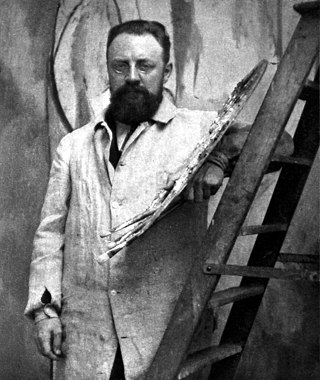
Henri Émile Benoît Matisse was a French visual artist, known for both his use of colour and his fluid and original draughtsmanship. He was a draughtsman, printmaker, and sculptor, but is known primarily as a painter. Matisse is commonly regarded, along with Pablo Picasso and Marcel Duchamp, as one of the artists who best helped to define the revolutionary developments in the visual arts throughout the opening decades of the twentieth century, responsible for significant developments in painting and sculpture.

André Derain was a French artist, painter, sculptor and co-founder of Fauvism with Henri Matisse.

Jean Dominique Antony Metzinger was a major 20th-century French painter, theorist, writer, critic and poet, who along with Albert Gleizes wrote the first theoretical work on Cubism. His earliest works, from 1900 to 1904, were influenced by the neo-Impressionism of Georges Seurat and Henri-Edmond Cross. Between 1904 and 1907, Metzinger worked in the Divisionist and Fauvist styles with a strong Cézannian component, leading to some of the first proto-Cubist works.

Henri Cartier-Bresson was a French artist and humanist photographer considered a master of candid photography, and an early user of 35mm film. He pioneered the genre of street photography, and viewed photography as capturing a decisive moment.
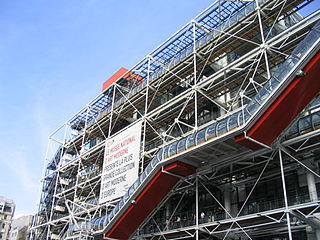
The Musée National d'Art Moderne is the national museum for modern art of France. It is located in Paris and is housed in the Centre Pompidou in the 4th arrondissement of the city. In 2021 it ranked 10th in the list of most visited art museums in the world, with 1,501,040 visitors. It is one of the largest museums for modern and contemporary art.
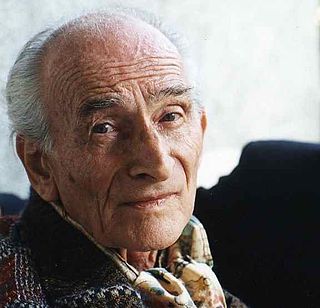
Balthasar Klossowskide Rola, known as Balthus, was a Polish-French modern artist. He is known for his erotically charged images of pubescent girls, but also for the refined, dreamlike quality of his imagery.
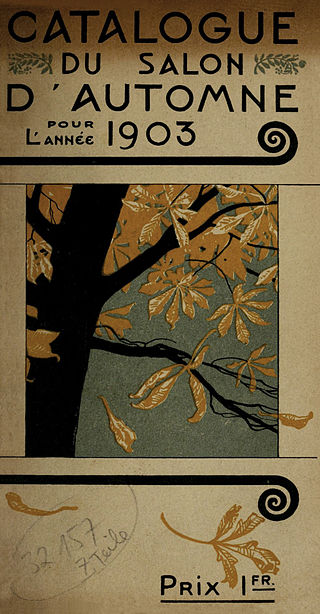
The Salon d'Automne, or Société du Salon d'automne, is an art exhibition held annually in Paris. Since 2011, it is held on the Champs-Élysées, between the Grand Palais and the Petit Palais, in mid-October. The first Salon d'Automne was created in 1903 by Frantz Jourdain, with Hector Guimard, George Desvallières, Eugène Carrière, Félix Vallotton, Édouard Vuillard, Eugène Chigot and Maison Jansen.
Albert Skira (1904–1973) was a Swiss art dealer, publisher and the founder of the Skira publishing house.

The Painter and His Model is a work by Henri Matisse painted late 1916, early 1917. It is currently in the collection of the Musée National d'Art Moderne, Centre Georges Pompidou, Paris. In this work Matisse depicted himself in his studio on the fourth floor of 19 Quai Saint-Michel, at work on his painting Laurette in a Green Robe (1916).
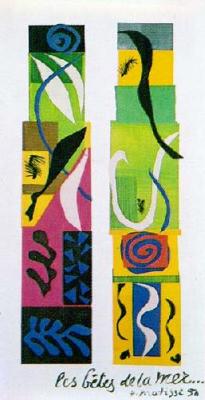
Beasts of the Sea is a paper collage on canvas by Henri Matisse from 1950. It is currently in the collection of the National Gallery of Art, Washington, DC. During the early-to-mid-1940s Matisse was in poor health. Eventually by 1950 he stopped painting in favor of his paper cutouts. Beasts of the Sea, is an example of Matisse's final body of works known as the cutouts.
Henri-Georges Adam was a French engraver and non-figurative sculptor of the École de Paris, who was also involved in the creation of numerous monumental tapestries. His work in these three areas is regarded as among the most extensive of the twentieth century.
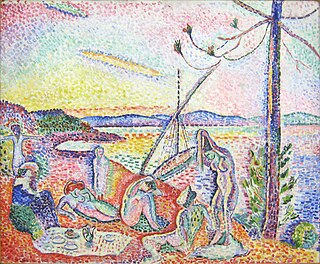
Luxe, Calme et Volupté is a 1904 oil painting by the French artist Henri Matisse. Both foundational in the oeuvre of Matisse and a pivotal work in the history of art, Luxe, Calme et Volupté is considered the starting point of Fauvism. This painting is a dynamic and vibrant work created early on in his career as a painter. It displays an evolution of the Neo-Impressionist style mixed with a new conceptual meaning based in fantasy and leisure that had not been seen in works before.

Fauvism is the style of les Fauves, a group of early 20th-century modern artists whose works emphasized painterly qualities and strong colour over the representational or realistic values retained by Impressionism. While Fauvism as a style began around 1904 and continued beyond 1910, the movement as such lasted only a few years, 1905–1908, and had three exhibitions. The leaders of the movement were André Derain and Henri Matisse.

Houses at l'Estaque is an oil-on-canvas painting by Georges Braque executed in 1908. It is considered either an important Proto-Cubist landscape or the first Cubist landscape. The painting prompted art critic Louis Vauxcelles to mock it as being composed of cubes which led to the name of the movement.

Le Chemin, Paysage à Meudon also known as Paysage avec personage, is an oil on canvas painted in 1911 by the artist, theorist and writer Albert Gleizes. The work was exhibited at the Salon des Indépendants during the spring of 1911, Paris; Les Indépendants, Musée moderne de Bruxelles, 1911; Galeries Dalmau, Exposicio d'art cubista, Barcelona, 1912; Galerie La Boétie, Salon de La Section d'Or, 1912. The painting was reproduced in the journal Le Siècle (1912) in an article titled Enquête sur le Cubisme, by Olivier Hourcade.

Paysage coloré aux oiseaux aquatiques is an oil painting created circa 1907 by the French artist and theorist Jean Metzinger. Paysage coloré aux oiseaux aquatiques is a Proto-Cubist work executed in a Post-Divisionist style with a unique Fauve-like palette. Metzinger's broad omnidirectional brushstrokes in the treatment of surfaces render homage to Paul Cézanne, while the luscious subtropical imagery in the painting are an homage to Paul Gauguin and Metzinger's friend Henri Rousseau.
Otho Lloyd (1885‒1979) was a painter and photographer married to the Russian émigré artist Olga Sacharoff. He was the elder brother of Arthur Cravan and a nephew of Constance Lloyd Wilde, the wife of the Irish writer and poet Oscar Wilde.
Hélène Adant (1903–1985), also known as Hélène Mossolova or Mossoloff, was a Russian-born French photographer. She started her career in France in the 1930s and worked with some of the leading French artists of her day.
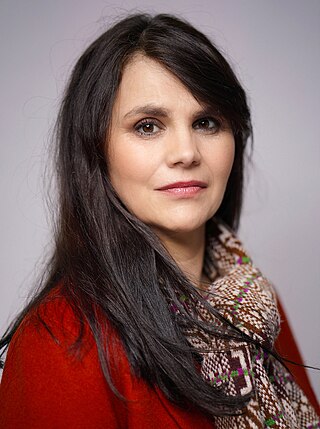
Cécile Debray, born November 20, 1966, is a French museum director, art historian and curator, specialist in modern and contemporary art in painting.
Harry Fuld was a German Jewish entrepreneur whose art collection was looted by Nazis after his death. Fuld founded a company for renting in-house telephones, which developed into one of the leading groups in the telecommunications industry in Europe. After Adolf Hitler and the NSDAP came to power at the beginning of 1933, the Nazi regime expropriated Fuld's heirs because the family business was considered "Jewish".















